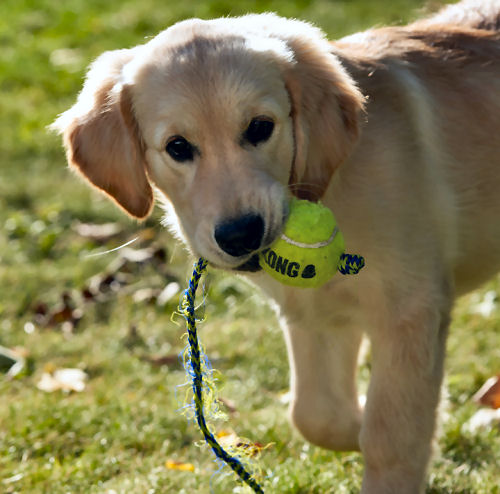Games are easy and fun dog training. And, over time, the most effective and long-lasting learning for your dog.

And that’s where we see people getting frustrated and tempted to use aversive methods. Just this week one of our puppy class students pleaded to use a pinch collar on his five-month old Golden Retriever. Because when he tried it, he got better attention immediately.
That’s the way aversives, pain training, works. You’d pay attention, too, if it was the only way to not get choked.
Long-term gains
Fortunately, this man does want to do better by his puppy. He’s a long-time aversive trainer, so positive, game-based dog training is new to him. He was accustomed to instant obedience from his dogs. But he had to enforce that throughout their lives. They didn’t obey because they understood. They obeyed because they wanted to avoid pain.
The issue with this puppy is that she’s smart, curious, and five months old. The other dogs and people in class are more interesting than her people. So the first step is to be more interesting than anything else around.
Building the bond
He’s used to tugging on the puppy’s collar whenever he wants her to look at him. It’s going to take a conscious effort on his part to change that. It’s habit to say her name and pop the collar, not even giving her time to move her head.
The hardest thing in positive reinforcement dog training is waiting. Patience is not only a virtue, it’s a requirement. Jack’s assignment is to say his puppy’s name and wait for her to look at him. Not say anything else. Not let her go wandering off. Just wait, calmly.
Eventually, with nothing else available to do, the puppy will look at him. And that’s when he pounces with a celebration and reward. That reward is whatever is most valuable to the puppy – food, a game of tug, or on-leash fetch, or even a little wrestling match.
She will learn that looking at her “dad” is the most fun thing to do. It always, every single time, results in happy, fun games. It’s the best thing ever! And that’s how you build your bond with your dog.
Checking in
Jack and his wife are under instructions to reward their puppy every single time she looks at either one of them. They have treat bowls in every room in the house, and pouches to carry outside. For three months, since they got her, the puppy hasn’t been encouraged to engage with them. The focus has been on the toy, the food, the leaves blowing down the street.
They will be able to claim her focus if they make the investment. What gets rewarded, gets repeated. If the puppy is rewarded every time she looks at them, she’s going to look at them a lot more. And, when her people are more interesting, she’s less likely to find everything else so distracting.
Long-term investments pay off
When the puppy understands that looking at her people will always result in good stuff, it’s a lesson learned for life. It may take longer to penetrate than choking. But it’s a conversion worth making. Nobody really wants to hurt their dog. When you know better, you do better.
